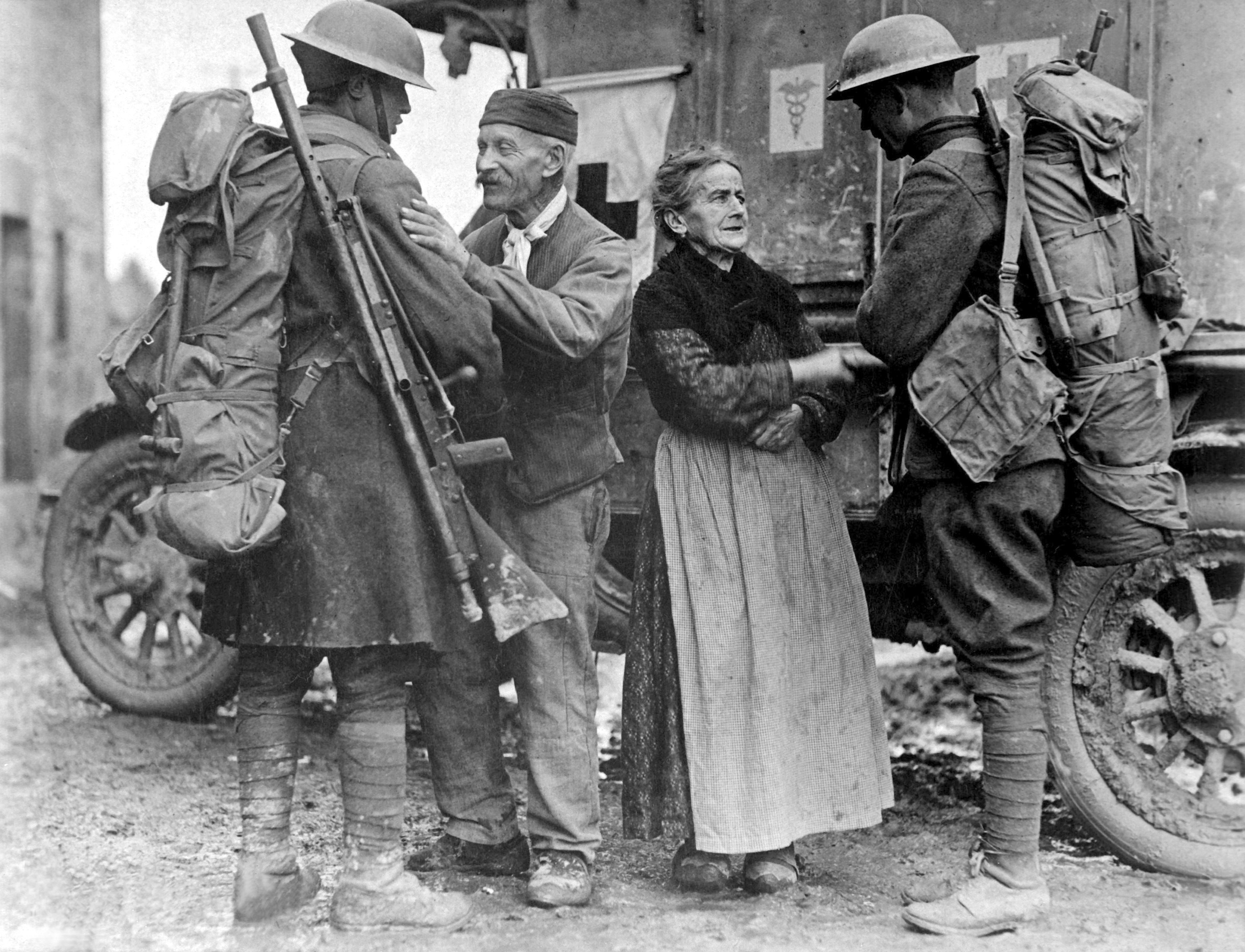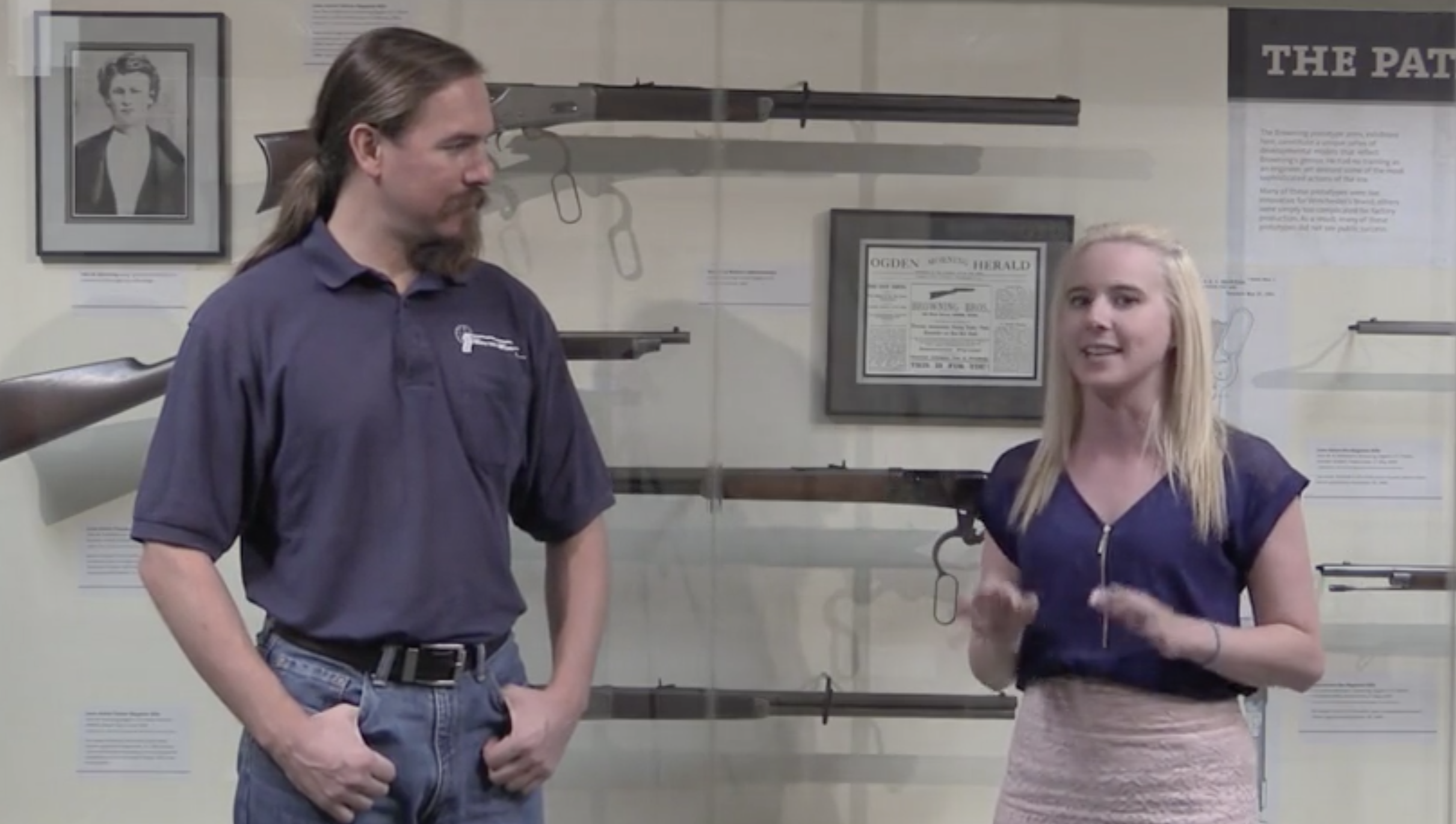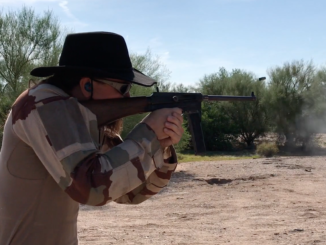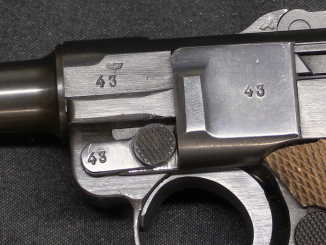
This is a pretty widely-published photo, but it sure is a good one. It also shows very clearly the US’ horrible excuse for a backpack of the time. For the record, the soldier on the left has a Chauchat in 8mm Lebel (sans magazine) and the soldier on the right has an M1903 Springfield rifle.




How can you tell that is an 8mm Chauchat with the magazine removed. Those were also made in 30-06 for the “Amis”.The only obvious difference is the magazine. The 30-06 guns were where the Chauchat got its reputation as a total piece of junk. My grandfather went to France with the AEF and was issued one. After it jammed during his first engagement and couldn’t be cleared he tossed it in the mud and picked up an M1917 from a fallen doughboy and soldiered on.
The most obvious difference is that the 30-06 version has a mag well built onto the receiver. The one in the pic is certainly the 8mm version Mle 1915.
My great uncle (Colonel, Transportation, AEF, 1917-18) said that the best way to use the .30-06 “Sho-Sho” was to let it get captured by the enemy.
Every time anyone tried to fire it, there’d be about a 50-50 chance that it would fail to fire or jam, one chance in three of a major parts breakage, and one chance in five that it would blow up in his face.
Better the enemy than one of ours, in his estimation.
cheers
eon
“.30-06 “Sho-Sho””
In fact problem was awful (wrong chamber dimensions) conversion to different cartridge. In case of French version (firing 8x50R) problems were caused by low quality of wartime production, firing long burst, holes in magazine (dirt entrance) and peculiar shape of 8x50R Lebel cartridge which mean 180-degree magazine and thus such way of spring rather than straight or near straight in other box magazines. Notice that Belgian variant chambered for more regular shaped cartridge (7.65 Argentine) work better https://en.wikipedia.org/wiki/Chauchat states that Belgian Army used it until 1930s.
Your “site sponsors” ad strip covers up the photograph by running all the way up the middle of it.
If you hold down the “Ctrl” button and roll your mouse center button backwards (toward you) it will minimize the background and reveal the whole picture but to normal size. This works on almost all websites and is especially useful for us Old-Blimd-As-A-Bat” folks. The reverse magnifies the website.
Alternatively:
Ctrl + do zooming
Ctrl – do dezooming
Ctrl 0 do normal size
or if you want just see image only:
Right Mouse Click @ image -> open image or show image
I knew about the ctl)+_ controls, but I had forgot about the CTL mouse roll. Thanks for the reminder, it’s a lot easier.
I must say, it’s nice to find a picture with complete IPTC info imbedded. Thanks!
That “horrid excuse for a backpack” brings up another topic for discussion: webbing worn by soldiers.
Back during the 1980s, there was a book “Twisted Web?” about the various web belts, Sam Browne belts, bandoliers, Bren Gun pouches, battle jerkins, skeletonised jerkins, Bosnian fishing vests, etc. worn by Canadian soldiers.
Flake jackets, body armour, etc. is another possible topic.
Which reminds me of pistol holsters … what about the sewn-in pistol holsters worn by Japanese paratroopers and British tank troopers?
“Which reminds me of pistol holsters … what about the sewn-in pistol holsters worn by Japanese paratroopers and British tank troopers?”
U.S. Army helicopter pilot’s survival vests [at least used to] have a holster for a 4″ S&W M&P or Colt Official Police type revolver sewn onto them.
The backpack might be horrible, but the respirator packs were just the right size to take a tupperware lunch box and a thermos flask.
What about other nations rucksacks? For example Rucksack M.1913
http://ah.milua.org/ryukzak-m-1913-2
used by Austria-Hungary look quite good for me.
When I served 50 years later, it was nearly identical. Cultural continuity, I guess.
This looks like one of those rucksacks/backpacks dated much later maybe. https://www.etsy.com/listing/263715321/us-world-war-two-era-canvas-rucksack?ref=shop_home_active_1
I am looking at the puttees and find them wrapped quite tight around the legs with more “rings” than Ian had on his replica uniform. Because of their shoes?
I had mine wrapped up to just under the knee; it looks like this guy has them only going about halfway up his calves. That puts the wrap spacing closer together, and makes it look like more.
Well, the dough boys can thank the idiots running the Ordnance Board of that era for giving them “second rate” machine guns. The backpacks are obviously not going to give the users much comfort. In fact, the horrible excuse of a French backpack looks less embarrassing since it doesn’t whack you in the rear when you’re sprinting across no-man’s land… Or am I wrong?
““second rate” machine guns”
To make things even more absurd: inventor of Lewis machine gun was U.S. citizen and offered his design to U.S.Army, but without success.
Lewis was threatened by his boss. “If you even THINK of sending one of your overpriced contraptions to the boys I’ll throw you in jail for insubordination and rip off your patches myself!!!” Crozier was pretty mad at Lewis already, to say nothing of the allegations that Lewis stole the design from Samuel McClean.
Still, if they can’t adopt Lewis MG due to non-technical reason, can’t they go with Hotchkiss Portative?:
http://world.guns.ru/machine/fr/hotchkiss-portative-e.html
doubtlessly it was heavier, but at least should be more reliable
The 1909 Benét–Mercié machine rifle was already in American service but a short production run (about 670 guns altogether for the US Army) and a cessation of production by Springfield Armory before 1917 meant that there were not enough to go around. Even worse, this American version of the Hotchkiss had ludicrously fragile firing pins and extractors and could not prevent strips from getting inserted the wrong way at night (which of course meant the gun was probably going to need 30 minutes of repairs every time somebody messed up in the dark). One must also remember that the US Army (prior to its entry in the Great War) wasn’t really keen on doing anything other than defending American territory (or chasing Pancho Villa with the M1909 pointed in his direction). If you had a gun that broke often no matter how nice you treated it, what makes you think that its French cousin will perform any better under the same conditions (mud, rookie troops, and nighttime operation difficulties)?
“that broke often no matter how nice you treated it”
https://en.wikipedia.org/wiki/Hotchkiss_M1909_Benét–Mercié_machine_gun
states that:
(…)However, Maj. Julian Hatcher was assigned to look into the issue after Columbus and found almost all the issues were due to inadequate training. US troops during the Villa Expedition received additional training and the M1909 was considered an effective weapon.(…)
Uh-huh… Effective only when the troops are trained and whenever said troops have TONS OF SPARE PARTS on hand. If your machinegun is inherently fragile, shouldn’t you also strengthen its internal workings while improving your training regimen!? If you run out of replacement guns, all your hard work is for nothing!
So, if American made were that really poor performers why British made were not? (as states https://en.wikipedia.org/wiki/Hotchkiss_M1909_Benét–Mercié_machine_gun France and Britain used the Hotchkiss M1909 through World War I and on into World War II.)
Perhaps the French and the British had better quality steel on hand (fewer parts breaking). If your machine gun’s internal workings have been improved and if you have good support from logistics, your guns will probably last longer than if your factories had cut your production run to less than one-thousand and somehow forgot how to make the spare parts (firing pins and extractors, that is).
Also, the American guns were improperly used because the inexperienced US Army brass (prior to the establishment of the machinegun schools) believed that all machineguns were strictly confined to the heavy defense role, which meant “keep firing whether or not you have a target and don’t even think about stopping until you’re told to stop, even if the barrel bursts.” Overheated barrels and overstressed receivers don’t go well with overstressed soldiers. And if you hadn’t noticed, I said the American production run was less than even one-thousand M1909’s. That meant if your guns got broken, “sorry, no way to repair your guns and nothing left in reserve.”
In substitute of ‘being there in person’ we rely onto guesses and hear-say. Isn’t that fun?
From my own memory, what I heard from my grandpa (A-H military) he was not specifically critical of any particular piece of equipment. I believe he carried M95 Stutz.
To end our discussing at topic: which is more reliable (or unreliable): 30-06 Chauchat xor 30-06 Hotchkiss Portative?:
LACK OF EVIDENCE
I don’t know any direct comparison between these two design in SAME conditions i.e. ammo from same batch, same moisture, same air temperature, same burst quantity and length
I don’t think I had actually seen that picture before.
The female looks more baffled than happy. Perhaps the soldier has attempted to speak French and told her “I am pleased to eat your camel.”?
He’s been in the trenches a while and has likely propositioned her as the most beautiful woman he’s ever seen.
Wonder how long it took those doughboys to wrap those leggings?
“horrible excuse for a backpack”
Are you casting aspersions upon the utility of unpacking everything to gain access to a single item? The M1910 infantry haversack allows the soldier the opportunity to consider if they really, truly need an item stowed in the pack; knowing that it will take twenty minutes to unpack and reach an item discourages them from remove these items from the haversack and thus prevent their loss.
Items on the packing list are not free and all due diligence should be taken to prevent their careless loss.
Are you saying that forcing a guy to carry an non-ergonomic pack will make him prioritize his inventory? The man might throw away his haversack and steal a French one instead! What if you were just about to get out something because the captain asked for it and in the next few seconds or so the other team popped out of nowhere to shoot your entire platoon? Are you going to abandon your pack, zip up the pack (taking you twenty minutes to do so under fire), or are you going to have a backpack that won’t require a ridiculously long time to pack?
According to my great-uncle, more than few doughfoots quietly “combat-lossed” that thing. Their solution was to put the issue wool blanket on top of the issue rubberized canvas groundsheet, put their equipment at one edge, roll it up, fold it over once and secure the ends with a buckled strap, and then drop it over their heads, slinging it diagonally from left shoulder to right hip. Yes, just like a Civil War “blanket roll”.
You can see this arrangement in some WW1 photographs. It’s often mistaken for a flotation device or “life preserver”.
French troops often did something similar; they didn’t like their rucks very much, either.
cheers
eon
Wars are not fought that way, Lieutenant.
To do what you’ve described is uncivilized and barbaric.
As long as we have our elan, we will turn the tide!
If they really, really wanted to prevent loss, they should have just kept everything safely stored in the depot. 🙂
Judging from other stories I’ve read, they did exactly that for many issue items.
Twenty minutes to get the pack stowed away only to realize that your pack of cigarettes are still inside. I’m shure that the doughboys would enjoy beating the designer of that pack with the horrible 30-06 Chachat.
The pack also prevented the soldier from bending very much at the waist due to the way it was secured to the belt. For this reason, it was never carried in the assault.
cheers
eon
Off Topic Sunday: A stolen WWI cannon was just sold for an undisclosed amount in a private sale. The buyer contacted police after learning of the theft.
Although auction houses have high prices (and steep commission) compared to buying something out of the back of a van in a parking lot late at night, at least they provide some insurance against the kind of total loss that results when buying stolen property and THEN going to the police.
http://www.sfgate.com/news/article/WWI-cannon-swiped-from-Richmond-Veterans-Memoial-7464827.php
Nice vintage photo as usual. Thanks for sharing.
Interesting to see the amount of “foreign” equipments, used by the US in 1917-1918.
Comming from the French: Chauchat + Hotchkiss m1914 + 75mm m1897 APX field gun + 155mm M1917 schneider howitzer + 155mm GPF long gun + SPAD series of aircrafts……
Comming from the British : Brodie helmet + SBR gas mask + M1917 rifle (1914 pattern rifle) + 8 inch MK6 howitzer + 9.2 inch howitzer + 75mm m1917 field gun (18 pdr mk II QF gun)…….
I think it shows both:
-The willingness to share commons items with their allies (and avoiding the risk of running out of ammo due to germans submarines)
-The lack of preparation for “modern” warfare.
However there were some “pure” american items such as M1903 Springfield, the M1912 uniform + M1910 backpack + M1911 colt + 4.7 inch M1906-1917 gun and so on. But these were “light” equipments, more appropriate to a kind of “Philippine / Mexican” expedition, than european trench warfare.
Important parts of exterior ballistics came from France. The G-table (air drag) was originally set up for velocities in meters per second. This French drag model, based on firing of French naval artillery projectiles, today is called G1 and still widely used outside the military.
I might add that WW2-vintage drag models G7 and G8 are of British origin.
I didn’t know that. Thanks for the info.
People should realise that the use of metric system for Nato artillery, came from WW1, when the US choosed the French system for their own guns.
Hence the standard nato caliber : 75mm, 90mm , 120mm , 155mm , have french origines.
It was only for the “big gun” cailber (4.2 inch, 8 inch and 9.2 inch) that the US choosed the british system or kept their own pre-WW1 system (and so Nato today).
poverty + alcoholism (wine..) + syphilis + starvation + cryptocommunism = frenchs midgets with the lower IQ of europa.